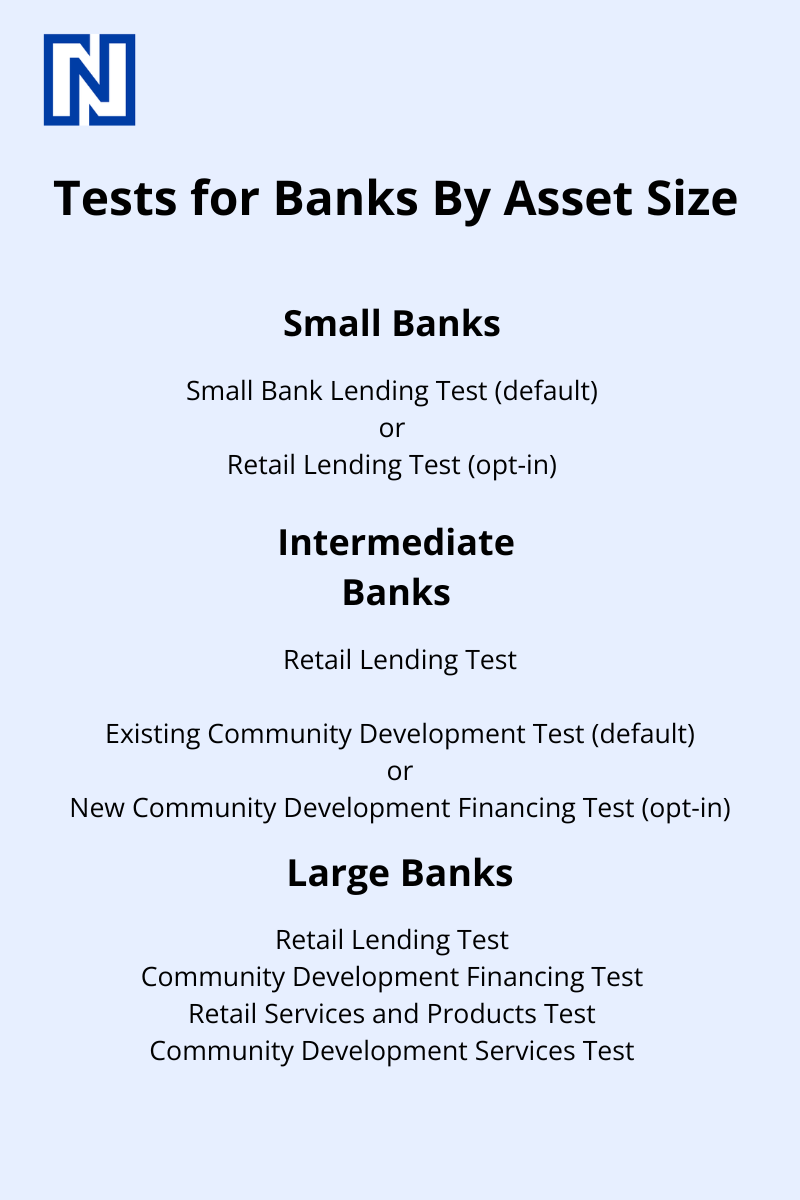Note: Under the interim final rule released by the agencies on March 21, 2024, CRA effective dates for the Facility Based Assessment Area provisions and the Public Notice provisions have been extended from April 1, 2024, to January 1, 2026.
After years of discussions and false starts, the Federal Reserve, FDIC, and OCC issued their final rule modernizing the Community Reinvestment Act (CRA) on October 24th, 2023. How will CRA modernization impact your bank? What do regulators hope to achieve? What are they looking for from banks? What should your bank do to prepare?
Read on to find out.
The almost 1,500-page final rule takes effect on April 1st, 2024.
The April 1st, 2024, effective date applies provisions from the final rule similar to current CRA regulations, such as facility-based assessment area delineations, the effect of CRA compliance on applications, CRA exam schedule public notice provisions, and the new public engagement provision.
Some of the key updates in the CRA modernization final rule include:
- Changes in asset size for small, intermediate, and large banks
- Clarification of the investments and loans that count as CRA activities
- Expansion of assessment areas beyond a bank’s facility-based assessment area under certain conditions
- New tests for evaluating CRA performance
Banks must comply with all the rule’s provisions by January 1, 2026 (aside from certain requirements taking effect January 1 2027).
Related: Top 5 Takeaways from Our CRA Modernization Webinar
Table of Contents
- Updated CRA asset thresholds for banks
- Why the agencies updated CRA regulations
- Expansion of CRA assessment areas
- The Retail Lending Test explained
- Additional tests for intermediate banks
- Tests for large banks
- CRA can feel heavy, but the right resources can lighten the load
Updated CRA asset thresholds for banks
Under the final rule, the agencies changed the asset size for banks’ CRA requirements. This will provide regulatory relief for roughly 800 smaller institutions while imposing new requirements on intermediate and larger banks.
Small banks are those with less than $600 million in assets. Under the old CRA requirements, small banks were those with less than $376 million in assets.
Intermediate banks are those with over $600 million in assets but less than $2 billion. Previous CRA requirements considered a bank large if it had more than $1.5 billion in assets.
Large banks are those with more than $2 billion in assets. This is an increase from the current benchmark of $1.5 billion. There will be additional data requirements for banks with over $10 billion in assets.
Under the final rule, the agencies will also assess CRA requirements for limited purpose banks under a different test. Consistent with current regulations, asset thresholds for small, intermediate, and large banks will be assessed for the prior two consecutive calendar years.
Ncontracts’ Take: Examiner expectations increase as your bank grows from small to intermediate or intermediate to large.
The agencies understand the importance of tailoring CRA evaluations and data collection based on bank asset size. They recognize that many community banks saw their balance sheets balloon over the past several years without having adequate time to prepare for compliance growing pains.
Small banks will still be evaluated under the Small Bank Lending Test – unless they opt out – and the final rule exempts small and intermediate banks from the new data collection requirements of large banks with assets greater than $2 billion and $10 billion.
At the same time, your bank needs a regulatory change management strategy long before it approaches these thresholds. Smaller and intermediate banks need to proactively plan for the much stricter CRA requirements they will face as they grow. Banks must focus on compliance and risk management as part of their growth strategy rather than waiting until they find themselves subject to regulations they can’t satisfy.
Why the agencies updated CRA regulations
The Community Reinvestment Act was part of the Housing and Community Development Act of 1977. CRA mandated that banks receiving FDIC insurance make loans and investments throughout the communities where they are located, particularly in low-to-moderate income (LMI) neighborhoods in their assessment areas.
But the law didn’t list specific criteria for compliance. Examiners consider a bank’s “performance context” to determine whether it satisfies CRA requirements. In the decades since its passage, bankers and examiners have struggled to understand what counts as CRA activities under this vague “performance context” standard.
Related: (Almost) Everything You Need to Know About CRA Performance Context
The final rule offers greater clarity on this front. It revises the community development definition to offer banks guidance on the loans, investments, and services deemed beneficial through:
- An updated list of eleven community development categories covering CRA activities
- A publicly available list of illustrative CRA activities that the agencies will maintain
- A confirmation process for the eligibility of activities
The agencies’ initial summary of the proposal for CRA modernization highlights their intention to “clarify what counts” as CRA community development activity – and they followed through in the final rule.
Expansion of CRA assessment areas
Facility-based assessment areas remain the foundation of CRA. But since the act was last updated in 2005, regulators have noted that many banks have expanded lending activities outside of their facility-based assessment areas.
The final rule accounts for this with three distinct assessment areas: the facility-based assessment area, the retail lending assessment area, and outside retail lending.
Facility-based assessment area: Not much has changed for banks regarding CRA requirements for facility-based assessment areas. “Banks will continue to delineate facility-based assessment areas in the MSAs or nonmetropolitan areas of states in which the following facilities are located: main offices, branches, and deposit-taking remote service facilities,” according to the rule.
One change in facility-based assessment areas is that larger banks must consider their assessment area as whole counties, while small and intermediate banks may still consider assessment areas as comprised of partial counties.
The final rule maintains that lending practices in facility-based assessment areas must not reflect illegal discrimination or avoid LMI census tracts.
Retail lending assessment areas: The final rule mandates that large banks must delineate a new assessment area – the retail lending assessment area – in an MSA or nonmetropolitan area of the state where the bank has a large concentration of closed-end mortgages or small business loans.
Retail lending assessment areas are those where large banks had at least 150 closed-end mortgage loans or 400 small business loans over the previous two calendar years.
Large banks that originate 80% or more of their loans inside their facility-based assessment area will be exempt from this rule.
Outside retail lending assessment areas: Under CRA modernization, the agencies will evaluate large banks, some intermediate banks, and small banks that opt to be evaluated under the Retail Lending Test (see below), for compliance in an outside retail lending assessment area.
The outside retail lending assessment area gives banks flexibility for CRA activities beyond their facility-based assessment area. With this provision, banks may be evaluated for CRA activities nationwide, which the agencies maintain adapts to the reality of digital banking.
For intermediate and small banks that opt to be evaluated under the Retail Lending Test, regulators will evaluate CRA performance in outside retail lending assessment areas on a mandatory basis if more than 50% of lending originated there.
Intermediate and small banks may also opt to have their outside retail lending assessment area evaluated even when a majority of loans originated inside their facility-based assessment area. This gives banks flexibility in meeting CRA requirements if they don’t satisfy the facility-based lending volume ratios under the Retail Lending Test.
Ncontracts’ Take: Regulators want to see your bank's activities and strategy for CRA compliance. The promise to publish a list of CRA-approved activities may prove helpful to institutions. However, it will still be largely up to banks to identify gaps in lending based on borrower income and geography.
Banks meeting certain conditions must collect CRA data outside their facility-based assessment areas if they meet or exceed the loan origination thresholds described above. Implementing a system for collecting and analyzing data will become increasingly important as banks plan to comply with CRA requirements inside and outside their assessment areas.
The Retail Lending Test explained
Small banks will be evaluated under the current Small Bank Lending Test, with the option of being evaluated under the new Retail Lending Test.
Intermediate and large banks will be subject to the Retail Lending Test, which offers a more quantitative way to measure compliance with CRA.
Under a metric known as the Retail Volume Screen, which pertains only to banks’ facility-based assessment areas, intermediate and large banks must meet or exceed 30% of the Market Volume Ratio. The Market Volume Ratio is determined by dividing the annual average loan originations at large banks with facilities in your assessment area by their average annual deposits.
The CRA modernization final rule concluded banks “that do not meet a Retail Lending Volume Threshold set at a 30% of Market Volume Benchmark are substantially underperforming their peers in terms of meeting the credit needs of their communities.”
The Retail Lending Test includes originations of mortgages, small business loans, multifamily loans, small farm loans, and auto loans – if auto loans represent a substantial portion of an institution’s portfolio.
Under the final rule, examiners will evaluate retail lending performance outside facility-based assessment areas – but not under the Retail Volume Screen. The outside retail lending area is nationwide, which gives banks considerable flexibility in satisfying CRA requirements.
The agencies understand that the evolution of digital financial products expands a bank’s assessment area. They want a more comprehensive approach that considers retail lending to LMI individuals and communities outside traditional assessment areas.
Additional tests for intermediate banks
Intermediate banks will undergo two tests equally weighted at 50% – the same as current CRA requirements. The Retail Lending Test will take the place of the present lending assessment. Intermediate banks can choose assessment under the existing Community Development Test or the newly established Community Development Financing Test.
Tests for large banks
Under CRA modernization, large banks will undergo four tests instead of three, weighted by examiners as follows:
- Retail Lending Test (40%)
- Community Development Financing Test (40%)
- Retail Services and Products Test (10%)
- Community Development and Services Test (10%)
The Retail Services and Products Test will assess a bank’s credit and deposit offerings in meeting the needs of LMI communities. This includes the bank’s availability of branches, remote service facilities, and digital access for customers.
The Community Development Services Test will be a detailed analysis of community development services in addition to the Impact and Responsiveness Review.

CRA can feel heavy, but the right resources can lighten the load
Compliance with CRA depends on the story your bank tells examiners. You need a solution that determines LMI investment ratios based on your defined assessment area to tell this story well.
With our Nlending fair lending solution, our team of experts reviews your CRA compliance data for quality control before uploading it onto the secure platform.
After crunching the numbers, your compliance team can easily analyze the geocoded maps and develop a narrative that conveys to regulators your bank’s lending commitment to the communities you serve.
Discover How First Financial Bank Mastered CRA Compliance


